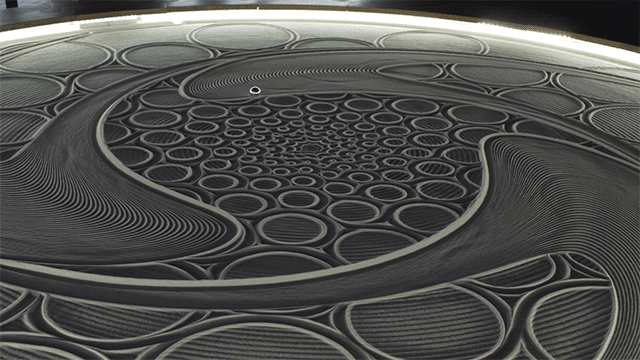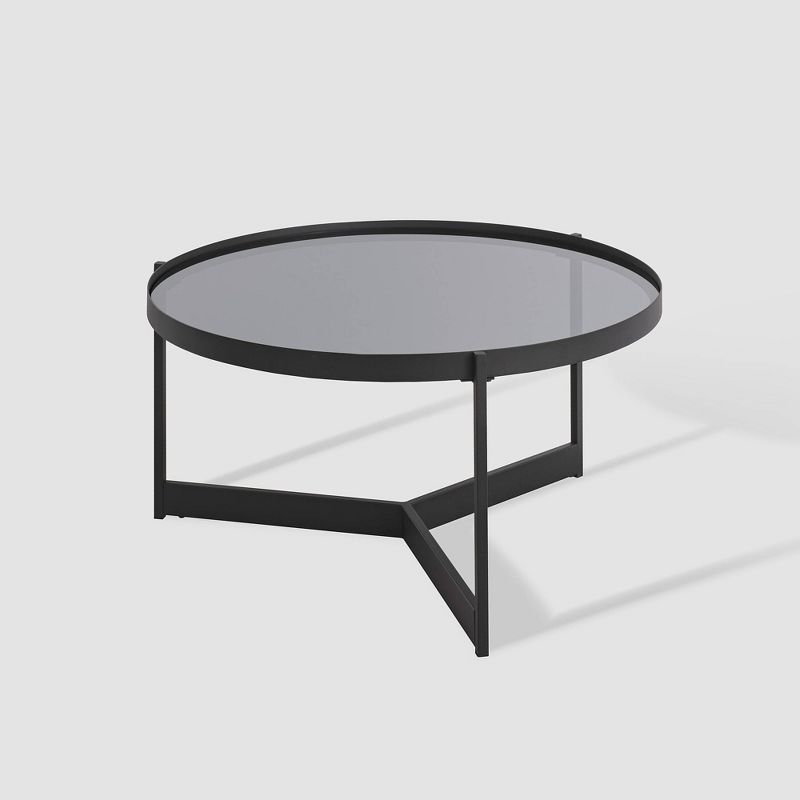What is a Sisyphus Table?
For my project, I am planning to make a small, minimalist style Sisyphus table. A Sisyphus table, named for the character in Greek mythology, is a table that uses a metal ball to slowly etch designs in a bed of fine sand, perpetually drawing and erasing what it has created. It can be as a clock or to draw interesting geometric patterns. The mechanism works by using a magnet beneath the bed of sand to drag the steel marble around the table. They often circular in shape with LEDs around the perimeter to illuminate the sand and cast shadows to make the designs pop. Below is a youtube video featuring a time-lapse of a large Sisyphus table over the course of 1 week.
Why I decided to choose this as my project?
I decided to create a Sisyphus table for a few reasons. Firstly, I just think they look cool and would like to have one in my room. This is something that I have wanted to do since high school as a personal project, but have never really had the opportunity or time to make one. It also combines several of my engineering interests: mechanical design and mechatronics. This project will allow me to work on my aesthetic design and surface modeling in solidworks, while I can also learn about GCODE and motor control. While choosing a project with motor control/electronics brings added complexity and may be a bit ambitious, I also have the opportunity to use this project for my mechatronics II graduate project which makes it worth it to me.
Aesthetic Vision
For the two aesthetics, I took inspiration from various furniture aesthetics because I feel like it is the most applicable to this project. The two that I landed on are modern Industrial and minimalist. Through more reflection I feel like the minimalist style will be better suited to this project, and more in line with my personal aesthetic preference.
Minimalist furniture is characterized by smooth and flat surfaces, often times in simple black and white. If color is present, it is generally monochrome with no patterns, hue changes, or patterns. There is no ornamentation present or very subtle, geometric ornamentation. The designs tend to focus on form from function. I feel like this aesthetic is easier to achieve with the materials and manufacturing methods that I have access to.
Table in the minimalist style:

Concept image generated by chatgpt:

I took inspiration from the table on the right, I think the clean black aesthetic with the subtle LED accents would fit this project perfectly. I am still deciding on whether to use fully flat sides, or to incorporate subtle geometric reliefs around the side.
Sketch of Sisyphus Table in minimalist style:

Alternate Aesthetic – Modern Industrial:
The modern industrial style takes inspiration from the classic industrial style, with a slightly more refined and minimalist approach. It often uses raw materials, such as rough and distressed wooden elements, as well as exposed steel. While I think this aesthetic would fit the table very well, getting access to good quality distressed wood for the body and steel for the frame could be a bit difficult and costly. If I went with this aesthetic I would most likely use cheaper materials and try to imitate the style of modern industrial.
Table in the modern industrial style:


Sketch of Sisyphus table with modern industrial style:

How I am going to make it:
Mechanism:
There are several different styles of mechanisms that people use to create Sisyphus tables. In principle, they work similarly to a 3D printer with 2 degrees of freedom (x and y). Underneath the bed of sand their is a magnet that moves the ball around the bed of sand .The various types of mechanisms have advantages and disadvantages in areas of complexity to build, complexity to control, and reliability. I will outline a few of the potential mechanisms that I considered and which one I ultimately chose to go with.
Double Arm:

The double arm mechanism uses a centrally mounted motor to control one arm, and then another motor connected to another arm. Controlling the angle of each motor sets the position of the magnet. This mechanism is very well suited for Sisyphus tables because it is the most optimized for circular and curvilinear shapes. This mechanism is the most “cool” to me, however I have concerns about the reliability and it also seems like it would take the most coding work to control.
Cartesian:

This mechanism works similarly to a 3d printer, with one motor controlling movement in the x direction, and another motor controlling motion in the y direction, typically driving belts and using linear rails. This mechanism seems the most straightforward to control, however it would require me to make the table a square. It could be used in a circular table design, however the marble would not be able to reach the edges of the table. Because I prefer the aesthetic of the circular table, this is a major disadvantage for this mechanism.
Belt, Lead Screw, or Rack and Pinion:
These three types of mechanisms are grouped together because of their similarity. The fundamental principal is one motor to control the angle of the belt, lead screw, or rack and pinion. Then the second motor controls the radius to position the magnet, using polar coordinates. I prefer this type of mechanism because it is a happy medium between the double arm and cartesian design, and because it uses polar coordinates it is well suited for the circular table. Between the 3, I am still choosing to between the rack and pinion and the belt driven design (first and 3rd image). These designs seem like the most cost effective to manufacture with the methods that I have available, and give the desired performance that I need.
Timeline Graphic:
| Week 1: | -Initial Research -Part sourcing and cost breakdown -Initial Mechanism Design Work |
| Week 2: | -Finish Mechanism Design Work -Order Parts -Begin aesthetic design work for exterior -Start Constructing Mechanism |
| Week 3: | -Finish Mechanism Construction -Coding -Finish aesthetic design work -Manufacture table |
| Week 4: | -Any remaining debugging and manufacturing -Project documentation |
Manufacturing Methods:
I am planning to use manufacturing methods that I am already familiar with to streamline the process. For the design I am going to use solidworks to create CAD. Using CAD and manufacturing methods that rely on CAD gives flexibility and confidence that the design will work before embarking on manufacturing. It also streamlines the manufacturing process by allowing on automated methods, rather than making things by hand with traditional methods such as wood cutting, metal working, etc. The main methods that I will use are laser cutting and 3D printing. For the mechanism, I am leaning towards to rack and pinion design which would allow me to use laser cut acrylic. For the exterior and structure, am am planning on using a combination of laser cutting and 3D printing. This would give me more flexibility to do interesting geometric patterns on the exterior. For the coding, I would like to use the Arduino. The Arduino will be used to control both the motor movement and the lighting. The lighting is an important aspect as it is what makes the design that are drawn in the sand to pop. I will use a simple colored LED strip that will be attached around the perimeter of the table. Creating the GCODE from scratch would be a pretty ambitious process. Luckily there is a convenient website called sandify.org that allows you to input your bed size, and choose from preset paths or generate your own. I am planning on having a few paths that the table will cycle through and clear. I am still debating on what level of control to incorporate with the user interface. At the very least I will have a start/stop switch, but I could add a second button to cycle through the various paths. With the popularity of 3D printers, I am confident that I will be able to find code and good references for converting that code into actual motor movement.
Conclusion:
This project is pretty ambitious due to the complexity and combination of mechanical, electrical, and coding challenges. It is something that I am going to have to consistently work on in the next coming weeks to complete on time. However I am still confident that I can pull it off due to it being a project that I am both personally interested in, and something that I can use for both my mechatronics and aesthetics and design class.
Sources:
https://www.target.com/p/modern-minimalist-tray-top-round-glass-coffee-table-black-saracina-home/-/A-87232962
https://home.tarkett.com/en_EU/node/what-is-minimalist-interior-design-style-8860#:~:text=Minimalist%20furniture%20and%20accessories%20focus,accessories%20or%20highly%20detailed%20ornamentation.
https://promnicesk.live/product_details/95543917.html
youtube.com



2 Comments. Leave new
Hi, I think this is such a cool idea and I love seeing those Sisyphus Tables whenever I do. I am wondering if there are ways to add it to something that would be unconventional maybe a watch, or a vertical one? Just wanted to throw some silly ideas out
I didn’t realize this in your initial post but combining this project with another class is such a good idea. I think it will be easy to get lost in the engineering side of this project so just remember this class is about the aesthetics. I think you have a great vision for how the product is going to turn out though. I am curious if you plan to do a circular or a square/rectangular design. I think this could simplify your mechanical challenges if you go for an xy cartesian coordinate system rather than the circular coordinate system. I am so excited to see the end product. How are you going to source really fine sand needed for this project. I think the sand at home depot etc would be too course for the ball to be able to move easily.